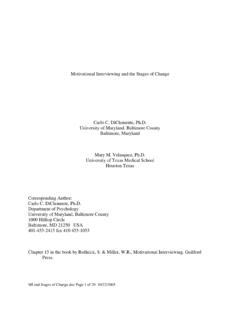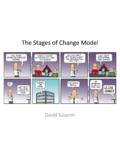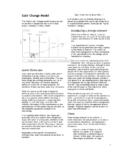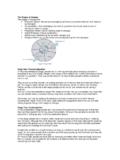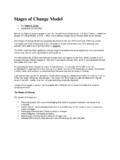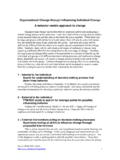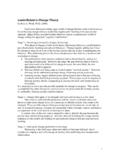Transcription of Detailed Overview of the Transtheoretical Model
1 Detailed Overview of the Transtheoretical Model Material adapted and updated for this Website from: Velicer, W. F, Prochaska, J. O., Fava, J. L., Norman, G. J., & Redding, C. A. (1998) Smoking cessation and stress management: Applications of the Transtheoretical Model of behavior change. Homeostasis, 38, 216-233. This is an Overview of the Transtheoretical Model of Change, a theoretical Model of behavior change, which has been the basis for developing effective interventions to promote health behavior change. The Transtheoretical Model (Prochaska & DiClemente, 1983; Prochaska, DiClemente, & Norcross, 1992; Prochaska & Velicer, 1997) is an integrative Model of behavior change. Key constructs from other theories are integrated. The Model describes how people modify a problem behavior or acquire a positive behavior. The central organizing construct of the Model is the Stages of Change. The Model also includes a series of independent variables, the Processes of Change, and a series of outcome measures, including the Decisional Balance and the Temptation scales.
2 The Processes of Change are ten cognitive and behavior activities that facilitate change. This Model will be described in greater detail below. The Transtheoretical Model is a Model of intentional change. It is a Model that focuses on the decision making of the individual. Other approaches to health promotion have focused primarily on social influences on behavior or on biological influences on behavior. For smoking, an example of social influences would be peer influence models (Flay, 1985) or policy changes (Velicer, Laforge, Levesque, & Fava, 1994). An example of biological influences would be nicotine regulation models (Leventhal & Cleary, 1980; Velicer, Redding, Richmond, Greeley, & Swift, 1992) and replacement therapy (Fiore. Smith, Jorenby, & Baker, 1994). Within the context of the Transtheoretical Model , these are viewed as external influences, impacting through the individual. The Model involves emotions, cognitions, and behavior.
3 This involves a reliance on self-report. For example, in smoking cessation, self-report has been demonstrated to be very accurate (Velicer, Prochaska, Rossi, & Snow 1992). Accurate measurement requires a series of unambiguous items that the individual can respond to accurately with little opportunity for distortion. Measurement issues are very important and one of the critical steps for the application of the Model involves the development of short, reliable, and valid measures of the key constructs. This paper will demonstrate applications of the Transtheoretical Model . The Model has previously been applied to a wide variety of problem behaviors. These include smoking cessation, exercise, low fat diet, radon testing, alcohol abuse, weight control, condom use for HIV protection, organizational change, use of sunscreens to prevent skin cancer, drug abuse, medical compliance, mammography screening, and stress management.
4 Two of these applications will be described in detail, smoking cessation and stress management. The former represents a well-researched area where multiple tests of the Model are available and effective interventions based on the Model have been developed and evaluated in multiple clinical trials. The latter represents a problem area where research based on the Transtheoretical Model is in the formative stages. Stages of Change: The Temporal Dimension The stage construct is the key organizing construct of the Model . It is important in part because it represents a temporal dimension. Change implies phenomena occurring over time. However, this aspect was largely ignored by alternative theories of change. Behavior change was often construed as an event, such as quitting smoking, drinking, or over-eating. The Transtheoretical Model construes change as a process involving progress through a series of five stages. Precontemplation is the stage in which people are not intending to take action in the foreseeable future, usually measured as the next six months.
5 People may be in this stage because they are uninformed or under-informed about the consequences of their behavior. Or they may have tried to change a number of times and become demoralized about their ability to change. Both groups tend to avoid reading, talking or thinking about their high risk behaviors. They are often characterized in other theories as resistant or unmotivated or as not ready for health promotion programs. The fact is traditional health promotion programs are often not designed for such individuals and are not matched to their needs. Contemplation is the stage in which people are intending to change in the next six months. They are more aware of the pros of changing but are also acutely aware of the cons. This balance between the costs and benefits of changing can produce profound ambivalence that can keep people stuck in this stage for long periods of time. We often characterize this phenomenon as chronic contemplation or behavioral procrastination.
6 These people are also not ready for traditional action oriented programs. Preparation is the stage in which people are intending to take action in the immediate future, usually measured as the next month. They have typically taken some significant action in the past year. These individuals have a plan of action, such as joining a health education class, consulting a counselor, talking to their physician, buying a self-help book or relying on a self-change approach. These are the people that should be recruited for action- oriented smoking cessation, weight loss, or exercise programs. Action is the stage in which people have made specific overt modifications in their life-styles within the past six months. Since action is observable, behavior change often has been equated with action. But in the Transtheoretical Model , Action is only one of five stages. Not all modifications of behavior count as action in this Model .
7 People must attain a criterion that scientists and professionals agree is sufficient to reduce risks for disease. In smoking, for example, the field used to count reduction in the number of cigarettes as action, or switching to low tar and nicotine cigarettes. Now the consensus is clear--only total abstinence counts. In the diet area, there is some consensus that less than 30% of calories should be consumed from fat. The Action stage is also the stage where vigilance against relapse is critical. Maintenance is the stage in which people are working to prevent relapse but they do not apply change processes as frequently as do people in action. They are less tempted to relapse and increasingly more confident that they can continue their change. Figure 1 illustrates how the temporal dimension is represented in the Model . Two different concepts are employed. Before the target behavior change occurs, the temporal dimension is conceptualized in terms of behavioral intention.
8 After the behavior change has occurred, the temporal dimension is conceptualized in terms of duration of behavior. Figure 1. The Temporal Dimension as the Basis for the Stages of Change Regression occurs when individuals revert to an earlier stage of change. Relapse is one form of regression, involving regression from Action or Maintenance to an earlier stage. However, people can regress from any stage to an earlier stage. The bad news is that relapse tends to be the rule when action is taken for most health behavior problems. The good news is that for smoking and exercise only about 15% of people regress all the way to the Precontemplation stage. The vast majority regress to Contemplating or Preparation. In a recent study (Velicer, Fava, Prochaska, Abrams, Emmons, & Pierce, 1995), it was demonstrated that the distribution of smokers across the first three Stages of Change was approximately identical across three large representative samples.
9 Approximately 40% of the smokers were in the Precontemplation stage, 40% were in the Contemplation stage, and 20% were in the Preparation stage. However, the distributions may be different in different countries. A recent paper (Etter, Perneger, & Ronchi, 1997) summarized the stage distributions from four recent samples from different countries in Europe (one each from Spain and the Netherlands, and two from Switzerland). The distributions were very similar across the European samples but very different from the American samples. In the European samples, approximately 70% of the smokers were in the Precontemplation stage, 20% were in the Contemplation stage, and 10% were in the Preparation stage. While the stage distributions for smoking cessation have now been established in multiple samples, the stage distributions for other problem behaviors are not as well known. This is particularly true for countries other than the United States.
10 Intermediate/Dependent Measures: Determining when Change Occurs The Transtheoretical Model also involves a series of intermediate/outcome measures. Typical theories of change involve only a single univariate outcome measure of success, often discrete. Point prevalence smoking cessation (Velicer, Prochaska, Rossi, & Snow, 1992) is an example from smoking cessation research. Such measures have low power, i. e., a limited ability to detect change. They are also not sensitive to change over all the possible stage transitions. For example, point prevalence for smoking cessation would be unable to detect an individual who progresses from Precontemplation to Contemplation or from Contemplation to Preparation or from Action to Maintenance. In contrast, the Transtheoretical Model proposes a set of constructs that form a multivariate outcome space and includes measures that are sensitive to progress through all stages. These constructs include the Pros and Cons from the Decisional Balance Scale, Self-efficacy or Temptation, and the target behavior.
